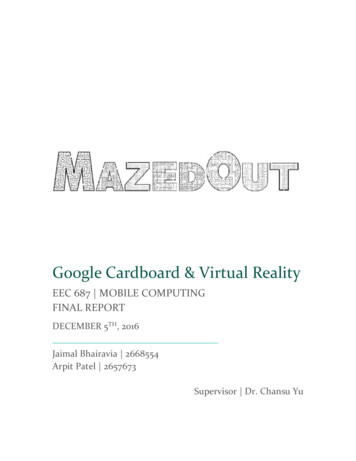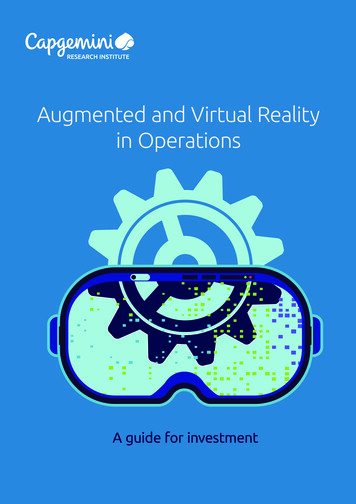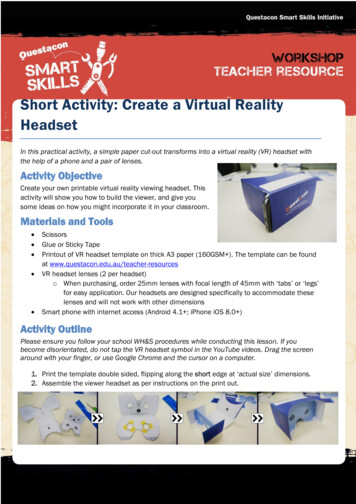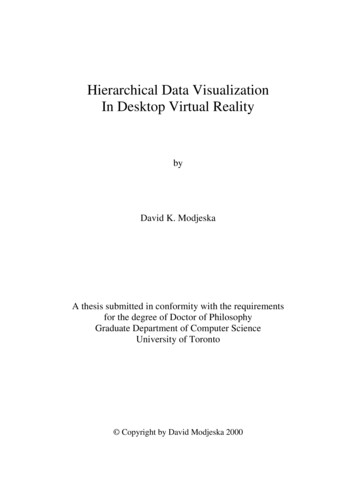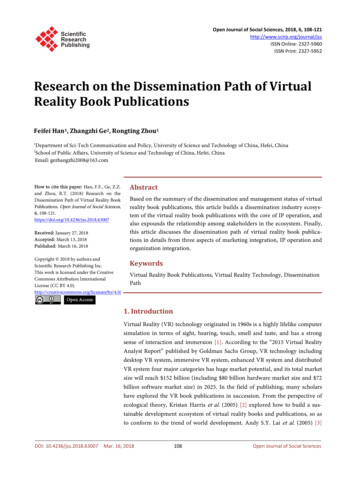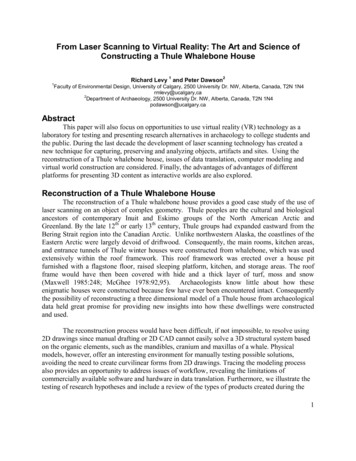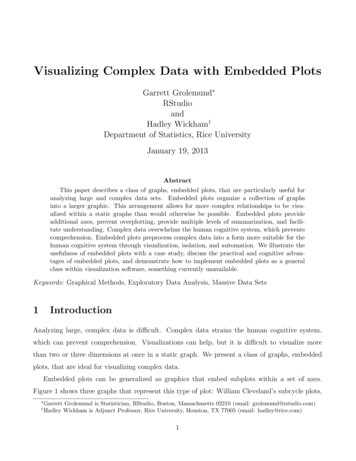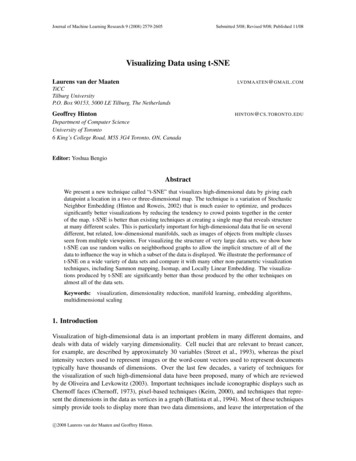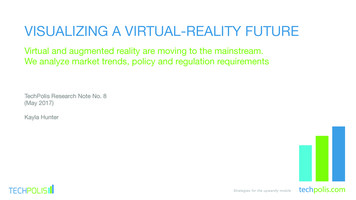
Transcription
VISUALIZING A VIRTUAL-REALITY FUTUREVirtual and augmented reality are moving to the mainstream.We analyze market trends, policy and regulation requirementsTechPolis Research Note No. 8(May 2017)Kayla Hunter
2CONTENTS03 Highlights12 Markets, Policies and Regulations04 Introduction19 Conclusion06 Definitions20 About TechPolis09 VR/AR Development and Applications20 About the Author
3Highlights Virtual and Augmented Reality have passed Gartner’s “peak of inflated expectations.” As many in the newsmedia begin to doubt the usefulness of VR and AR, this is exactly the moment the technology is ready to gainmarket traction. Beyond entertainment, VR and AR have the potential to improve:o the way we learno the effectiveness of healthcareo how we travelo how we buy products In order for the technology to become widespread, updates will need to be made to 3G/4G broadband networksand smartphone hardware As VR/AR spread, data regulators will have to address how personal data privacy and intellectual property rightswill be enforced in this new technology frontier Collaboration between the private and public sectors is vital to develop the policies and regulations required toaccommodate VR/AR While most of the core technology is being developed in the United States, Chinese consumers are adoptingVR/AR at the fastest pace in the world.
4IntroductionFor many, elaborate alternate universes in the style of the 90’s movie The Matrix spring to mind when virtual realityis mentioned. While this type of world is still a long way off, in just 20 years virtual reality (VR) and its sistertechnology, augmented reality (AR), have evolved to the point where they are starting to to have major impactson society (as brought home by the Pokémon Go phenomenon). Their potential extends beyond their early usein games and entertainment to sectors such as tourism, retail, education, and medicine.In less than a decade from now, it could be commonplace to project images of grocery store items into yourkitchen while you shop online, or consult ‘in person’ with your doctor by sliding on a pair of goggles. But if weare on the cusp of such monumental changes, why haven’t we all heard more about VR/AR yet?
5Figure 1: Gartner 2016 Hyper Cycle for Emerging Technologies[1]The Gartner 2016 Hype Cycle for EmergingTechnologies can give us clues. In Figure 1, wesee that both VR and AR have moved beyondwhat Gartner refers to as the ‘peak of inflatedexpectations’ and currently find themselves in the‘trough of disillusionment.’ Companies who haveinvested in this technology, known as ‘enablers,’anxiously wait for demand to grow, but the rate offailure is high at this delicate stage. Paradoxically,as many in the news media begin to doubt theusefulness of VR and AR, this is exactly themoment when we should expect to seeapplications of the technology increase. A smallnumber of companies who are most successfulin developing the technology will begin todominate the market. As we enter new territorywith VR and AR, it will entail updates totelecommunications infrastructure, laws, andregulations. This means we need to understandand project how people will interact with thetechnology and what issues may arise.[1] Walker, Mike J. “Track Three Trends In The 2016 Gartner Hype Cycle For Emerging Technologies,” August 29, 2016. Forbes. e-for-emerging-technologies/#4d64771c5e6c
6DefinitionsIn order to better understand the possibilities and limitations of these emerging technologies, it is important toestablish concrete definitions. In news reports on VR and AR, it is common to see puzzling descriptions that eitherdo not clearly describe their functions, or do not differentiate between the two. In Figure 2 we compare variousaspects of virtual and augmented reality to more clearly define the technologies.
7Figure 2: Understanding Virtual and Augmented RealityVIRTUAL REALITYAUGMENTED REALITYWhat is it?An experience where the real world is replaced by a virtualworld. Users can no longer see their physical setting andare instead immersed in a computer-generated, threedimensional world.An experience where the real world is combined withvirtual objects, images or words. Users can still seetheir physical setting, but computer-generated imagesare projected onto it.Why would youuse it?VR is useful in situations where transporting yourself to aspecified place is inconvenient or impossible.AR is useful in situations where seeing additionalinformation would improve a real-life experience.How do you useit? Device (s).1. HeadsetA virtual world is projected via 360degree video within this device. Asusers move their head, the imagesmove with them. 2016 marked thelaunch of commercial headsets,with Oculus Rift, HTC Vive, SonyPlayStation VR, and Samsung GearVR dominating the market.1. Head mounted displayGlasses or goggles with informationoverlaid. Google Glass andMicrosoft HoloLens are currently inthe development phase.2. Smartphones or tabletsDisplay both computer images andreal objects using the camera.3. Spatial DisplayComputer images are projectedonto the physical environment.[3][2] By Loïc Le Meur (Flickr: Loïc Le Meur on Google Glass) [CC BY 2.0 (http://creativecommons.org/licenses/by/2.0)], via Wikimedia Commons[3] Perdue, Tim. “Applications of Augmented Reality,” April 7, 2017. Lifewire. -reality-2495561[2]
8VIRTUAL REALITYIn what sectorscan we expect tosee it?AUGMENTED REALITYIn some fields we see both VR and AR: Video games Healthcare Education Engineering & DesignIn other situations where you cannot or do not need to bephysically present, VR makes more sense: Virtual tourism E-commerce Real estate Live entertainment Business meetingsWhen you need to manipulate a physical object,AR makes more sense: Museums & Tours Interior Design & Construction Retail Stores Vehicle Navigation Mechanical RepairsNow that we understand what the different technologies are, will virtual reality come on to the scene more quickly, or is it augmented realitythat will start seeing more use?In Figure 2, we see that VR headsets are more advanced commercially than AR hardware is. Although many experts have expected to seeVR come into mainstream use more quickly, in 2016 the biggest success in the industry was Pokémon Go, an AR game that only requiresthe use of a smartphone. As of 2017, there is much speculation among industry experts about exactly how and when these technologies willtake off. But the consensus is they will, as applications become clear to industries able to benefit from them, and proper infrastructure is inplace for widespread use.“The internet democratized knowledge, VR will democratize experiences.”(Pete Sena, founder of Digital Surgeons)
9VR/AR Development and ApplicationsTo better envision what the future of VR/AR will look like, we will examine use cases in four sectors: video games,healthcare, education, and retail.GAMINGAs with many technologies, the video game industry has been the pioneer of virtual and augmented reality.Beginning in the 1990s with 3-D headsets like the Virtual Boy by Nintendo, later devices such as Microsoft’s Kinectand Nintendo Wii used motion sensors for players to interact with virtual games. Currently, the VR headset marketis geared towards games and entertainment applications, as this is the first consumer market to interact with thetechnology. Goldman Sachs predicts video games will remain the largest market by 2025, but will open the doorfor other applications.HEALTHCAREVR and AR promise enormous gains in the field of healthcare, in both training and service provision. VR can allowmedical students to practice surgery in a highly realistic environment in which they can afford to make mistakes.Similarly, in real-life situations, VR enables doctors to better plan a surgery using 3D images of the actual organthey are going to operate on. This reduces risk and allows for more precise preparation in dire circumstances.
10An illustrative example of this took place in June 2016, when a cardiologist in Miami used VR to save the life of ababy who was born with only one lung and half a heart.[4] The physician downloaded images of the infant’s heartonto his iPhone and used Google Cardboard, an inexpensive but effective VR headset, to explore the inside of theheart from all angles—something not possible on a computer screen or with a 3D printout. This technology waskey to his planning and inventing new surgery techniques. As cases like this become better known, we can expectto see greater investment in VR/AR for healthcare purposes.In June of 2016, a cardiologist in Miami used VR to save the life of a baby who was born with only one lungand half a heart. The physician downloaded images of the infant’s heart onto his iPhone and used GoogleCardboard to explore the inside of the heart from all angles.EDUCATIONVR and AR have the potential to revolutionize educational experiences akin to the way the Internet changed theprocess of accessing knowledge. Research in child development and education has proven children learn andretain knowledge better from concrete, first-hand experiences than more passive forms of learning, such aslistening to lectures. With VR, students will be able to virtually build models or machines, or ‘travel’ to distant landsand interact with students from different cultures.[4] Cohen, Elizabeth. “Google Cardboard Saves Baby’s Life,” January 7, 2016. CNN.com. ard-baby-saved/
zSpace, an ‘edtech’ startup in Silicon Valley, is already providing such experiences for students. With zSpace 200,students use AR to dissect holograms of animals using special glasses and a stylus.[5] While devices such as thisare currently too expensive for widespread use in public schools, economies of scale will kick in. As thetechnology matures and its penetration expands, prices will go down, as was the case with the smartphoneindustry.[6]RETAILWhile e-commerce is booming, there remains an annoying downside to shopping online—opening a box to findwhat you were delivered is not what you expected. While more and more consumers turn to online retailers likeAmazon for convenience, many still prefer to shop in-store because they want to see and touch the item or try onclothes.[7] VR has the potential to change the online shopping experience by allowing people to interact virtuallywith the item they are viewing as if they were there in person. In stores, AR can also be used with smartphones toscan a product and display reviews and information about it. It can also allow you to project how a new piece offurniture will fit into your home. Both technologies stand to improve the experience for the shopper and increasesales.[5] zSpace.com https://zspace.com/videos/how-to.zspace-200[6] Sena, Pete. “What the coming educational VR revolution teaches us about the tech’s future,” December 16, 2016. TechCrunch. s-future/[7] BI Intelligence. “More retailers are adopting AR and VR technology,” June 22, 2016. Business Insider. adopting-ar-and-vr-technology-2016-6 11
12Markets, Policies and RegulationsIn order for virtual and augmented reality to have the type of impact Goldman Sachs (see Figure 3) is projecting,investing in technology development is not enough. Governments will need to work with industry leaders to designpolicies to facilitate the widespread use of AR/VR, as well as craft regulations to protect users to prevent havingrights infringed upon. In this section we assess initial market trends and discuss several areas that will be newpolicy and regulatory territory for VR/AR.China is outpacing the United States in investments in VR, even though much of the innovation is stillcoming from American firms. While initial VR use in the U.S. has been limited to those willing to invest in aheadset, in China VR Internet cafes and “experience zones” have allowed more consumers to access andrent the technology.MARKETSMarkets are beginning to move both to develop the technologies and to have consumers adopt them. At themoment, China is outpacing the United States in investments in VR, even though much of the innovation is stillcoming from American firms. In 2016, there was an estimated two thousand VR and AR companies worldwide,with a projected market potential of 150 billion by 2020, with the U.S. leading.[8][8] Hamblen, Matt. “Virtual reality needs US gov’t backing,” August 2, 2016. Computer World tml
13But while initial VR use in the U.S. has been limited to those willing to invest in a headset, in China VR Internetcafes and ‘experience zones’ have allowed more consumers to access and rent the technology—in essenceproviding beta tests.[9] Due to the popularity of these experience zones, a greater number of companies isinvesting in VR in China than anywhere else.In 2016, Goldman Sachs released a report with its hardware (devices) and software (applications) projectionsfor the industry. The report examined potential in video games, healthcare, engineering, live events, videoentertainment, real estate, retail, military, and education. It found a combined market opportunity of 65 bn by2025. Figure 3 breaks down the sectors standing to be impacted the most, both in terms of potential revenueand number of users.[9] Hanson, Lisa. “China’s Year of Virtual Reality,” December 23, 2016. Forbes. 3/chinas-year-of-virtual-reality/#3c3c002858b0
14Figure 3: VR/AR Revenue Opportunity 2025
15POLICY VS. REGULATIONTo better understand how this t
onto his iPhone and used Google Cardboard, an inexpensive but effective VR headset, to explore the inside of the heart from all angles—something not possible on a computer screen or with a 3D printout. This technology was key to his planning and inventing new surgery techniques. As cases like this become better known, we can expect to see greater investment in VR/AR for healthcare purposes .
